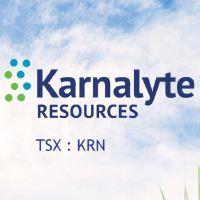 nowwhat2
3 years ago
nowwhat2
3 years ago
@Newton Very smart commentary here, imo.
1) Wynyard is already permitted and “construction ready”
2) Environmentally advantaged project, already EIS approved (no surface tailings ponds or piles)
3) Located in Saskatchewan, a true pro-resource province
4) Publicly traded fertilizer stocks are in short supply, demand is rising
5) Tight share structure w/ 42 mil out (never rolled back), key stakeholder (38% equity) and financier (non-binding LOI back in 2016 to lend up to $700 million) via state-backed Gujarat Fertilizers & Chemicals
6) Karnalyte continues to be valued at just 1% of NPV as per a Bankable Feasibility Study (using Can $466 per ton Potash) estimated $3.4 Billion for all three phases of project development
7) KRN shares are levered to Potash via 150 million tonnes of Proven and Probable reserves -- Please check my math but that would be like paying less than $1 per ounce of Gold in-ground (proven and probable)
8) ^^^calculation does not include any worth for Magnesium, a by-product of Potash production, or Nitrogen (a separate project and possible spin-off)
9) Majors like BHP and Nutrien operate in Saskatchewan and they’ve demonstrated long-term confidence by upping their investments in Sask. The Jansen Project may cost BHP up to $5.7 billion.
10) Fertilizers are an essential commodity and fertilizers are fast becoming a national security issue. India is taking immediate action by increasing subsidies to farmers, angling to secure long-term supplies, and allocating capital toward building new fertilizer plants. Gujarat, a state-backed corporation is Karnalyte's largest shareholder and off-taker.


